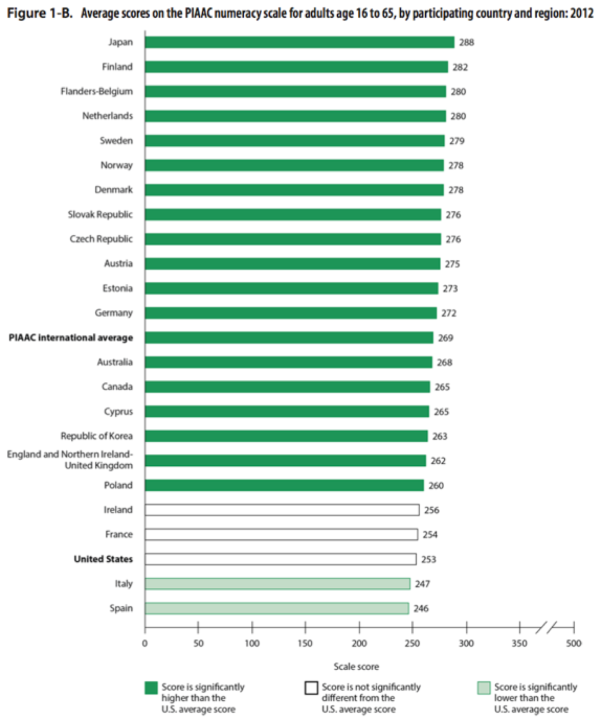Fewer than 10% of U.S. adults are good with numbers
Just 9% of Americans can identify the percentage of men who had more than six years of schooling in 1970 from two stacked-column bar graphs representing how many years of schooling men and women in Mexico have had by decade.

Which means that if you create charts and graphs or explain numbers for these folks who are rank high on the numeracy scale, you’ll miss 91% of U.S. adults ages 16 to 65.
That’s according to the 2013 Program for the International Assessment of Adult Competencies, or PIAAC. PIAAC is a cyclical, large-scale survey of adult skills, developed and organized by the Organization for Economic Cooperation and Development (OECD).
The study looks at the level of literacy and problem solving in technology-rich environments, as well as numeracy. The numeracy study tested four areas of adult literacy and numeracy skills, or how well people meet the mathematical demands of daily living in:
- Quantity and number
- Dimension and shape
- Pattern, relationships and change
- Date and chance
U.S. adults have basic numeracy skills
In the United States, adults weighed in at an average numeracy rate of 253 out of 500. That puts us at level 2, or basic, numeracy skills.
Just 9% of Americans 16 to 65 are proficient at mathResults of the 2013 PIAAC |
|||
| Proficiency levels | U.S. adults 16+ | Skills | Sample task |
| Below level 1 Nonliterate 0-175 |
10% | Perform basic tasks: counting, arithmetic with whole numbers. | Review four price tags, which include the date packed, then indicate which item was packed first. |
| Level 1 Below basic 176-225 |
20% | Perform one-step tasks: count, sort, perform math, understand simple percentages (such as 50%). | Calculate how many layers of candles are in the box that says there are 105 candles in the box and shows there are five rows of seven candles. |
| Level 2 Basic 226-275 |
34% | Perform two or more calculations — simple measurements, spatial representations and estimates — and interpret simple tables and graphs. | Review a motor vehicle logbook with columns for dates of trip, odometer readings and distance traveled; then calculate trip expenses at 35 cents a mile plus $40 a day. |
| Level 3 Intermediate 276-325 |
27% | Understand and work with mathematical patterns, proportions and basic statistics expressed in verbal or numerical forms. | Review an illustration of a flattened box identifying its dimensions, then identify which of four pictures best represents the assembled box. |
| Level 4/5 Proficient 326-375 |
9% | 4: Perform analysis and complex reasoning; understand statistics and change and spatial relationships; communicate well-reasoned answers.
5: Understand complex abstract mathematical and statistical ideas embedded in complex tasks; draw inferences, arguments or models; justify, reflect on solutions or choices. |
Review two stacked-column bar graphs representing how many years of schooling men and women in Mexico have had by decade, then identify the percentage of men who had more than 6 years of schooling in 1970. |
That means that, on average, we can figure out how many layers of candles are packed in a box of 105, with five rows of seven candles per layer. But we struggle to calculate trip expenses at 35 cents a mile plus $40 a day from a motor vehicle logbook with columns for date of trip, odometer readings and distance traveled.
U.S. numeracy averages basic
Results of the 2013 PIAAC

That score also puts us at the bottom of the pack internationally. In the 2013 study, the United States earned:
- Lower overall numeracy scores than the international average
- A higher percentage of low performers than the international average
- Lower numeracy scores than we had in 2003
Worse: Our overall numeracy score has taken a nine-point dive since the 1993 study.
_____
Source: “Literacy, Numeracy, and Problem Solving in Technology-Rich Environments Among U.S. Adults: Results from the Program for the International Assessment of Adult Competencies 2012,” Program for the International Assessment of Adult Competencies, or PIAAC

Leave a Reply